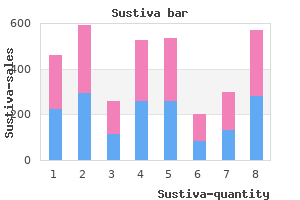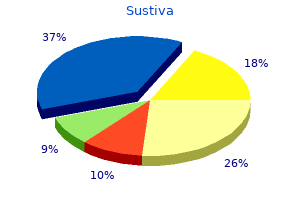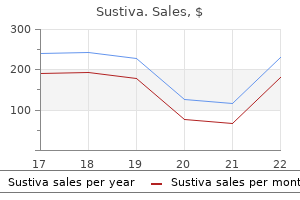Sustiva

"Sustiva 600 mg without a prescription, medications quit smoking".
W. Ilja, M.A., Ph.D.
Clinical Director, Roseman University of Health Sciences
Extreme events such as deep sea ocean swells symptoms throat cancer discount sustiva 200 mg overnight delivery, particularly high temperatures and cyclones medicine 75 purchase 200mg sustiva with visa, can affect the ability of ecosystems such as coral reefs and mangroves to provide services crucial for livelihoods and food security treatment irritable bowel syndrome effective 600 mg sustiva. Climate change and carbon absorption in the aquatic systems are and will continue to manifest change in the aquatic systems through increases in water temperatures symptoms 3 months pregnant buy cheap sustiva 200 mg on-line, increased thermal stratification, changes in salinity and freshwater content, changes in oxygen concentrations and ocean acidification. Coral reef systems, housing one out of four marine species, will be at increased risk due to double pressure of rising temperatures and increasing acidification. Since most aquatic animals are cold-blooded, their metabolic rates are strongly affected by external environmental conditions, especially temperature and available oxygen. Changes in temperature can have significant influences on the reproductive cycles of fish, including the speed at which they grow, reach sexual maturity, and the timing of spawning (Perry et 16 Climate change impacts on food security: overview of latest knowledge al. The reduction in available oxygen levels (related to the warming of surface water) will cause decreases in maximum body weight of fish species around the globe resulting in lower catch potentials in the near future. Models based on predicted changes in environmental conditions, habitat types and phytoplankton primary production forecast a large-scale redistribution of global marine fish catch potential, with an average 30 to 70 percent increase in high-latitude regions and a drop of up to 40 percent in the tropics (Cheung et al. In the Mediterranean, it has been observed that invasive species from lower latitude regions have arrived in recent years at the rate of one introduction every four weeks. Most of the non-native species have been observed to migrate northward by an average of 300 km since the 1980s, trying to follow their natural chemical and physical habitat (Streftaris, Zenetos and Papathanassiou, 2005). The increasing pressure on aquatic resources through climatic drivers and human stressors such as pollution and overfishing could result in a serious shortage of capture fisheries production. In addition to the gradual development of climate change-related drivers, variability events. For example, rising sea levels and floods displace brackish and freshwaters in river deltas, wiping out some aquaculture practices and destroying wetlands. The share of fish raised or caught in inland waters represented about 40 percent of total apparent fish consumption in 2013. In fact, 45 percent of the reported capture fish production in the least developed countries is coming from inland fisheries. That the production from inland fisheries is threatened by changes in precipitation and water management and the frequency and intensity of extreme climate events (Brander, 2007) is clear. Importantly, abundance and species diversity of riverine fishes are particularly sensitive to disturbances, since lower dry season water levels reduce the number of individuals able to spawn successfully and many fish species are adapted to spawn in synchrony with the flood pulse to enable their eggs and larvae to be transported to nursery areas on floodplains. River ecosystems are particularly sensitive to changes in the quantity and timing of water flows, which are likely to change with climate change. Initial assessments show that the impacts of climate change on fisheries and aquaculture will be felt most acutely in Africa and South Asia (Allison et al. Climate change is also one of the key drivers of the erosion of genetic resources for food and agriculture, the raw materials that local communities and researchers rely upon to improve the quality and output of food production. The stressors and risks posed by climate change on the various sectors of genetic resources for food and agriculture (plants, animals, forests, aquatic resources, invertebrates and micro-organisms) are manifold. The crop varieties, animal breeds or fish and forest species populations that will be required for the changing climate conditions will have to come from the existing pool of genetic resources for food and agriculture. However, climate change is also threatening the strategic reservoir of crop and livestock genetic resources from which to breed the varieties that will be needed to adapt production systems to future challenges. As conditions change, varieties and breeds may be abandoned by farmers and livestock keepers, and may be lost forever. Catastrophic extreme weather events such as floods and droughts, which in many parts of the world are expected to become more frequent because of climate change, can pose an immediate threat to the survival of breeds and varieties that are raised only in specific small geographical areas. Forest tree populations are unlikely to be able to migrate sufficiently quickly to keep pace with the changing climate (Loo et al. They will therefore have to adapt in situ, relying on their phenotypic plasticity and genetic diversity. Some scientists think that many tree populations will be able to cope relatively well with the effects of climate change. Predictions for tropical tree species tend to be more pessimistic than those for temperate and boreal species.

Iraq has sentenced more than 3 medicine 3202 purchase sustiva 200mg mastercard,000 people to death on charges of terrorism since 2013 symptoms bladder cancer generic 600 mg sustiva, including foreign nationals shinee symptoms order 600mg sustiva with visa. The Iraqi legislation applies a mandatory sentence of capital punishment for anyone convicted of being a member of a terrorist organisation in treatment 2 buy sustiva 600mg free shipping, without any consideration of the nature or scope of their role. They follow expeditious, unfair trials based on confessions often obtained under torture and other degrading treatment. In Mauritania, most of the people on death row are allocated to a remote prison in the northern desert area of the country, effectively cut off from contact with families and lawyers. This is compared to 261,000 in the year 2000, representing a rise of nearly 84 per cent in 14 years. In 2019, it was revealed through an annual poll that, for the first time, the majority of Americans believe that life imprisonment is a better approach for punishing murder than the death penalty. Recent amendments to the penal code in Kyrgyzstan also introduced whole life sentences, eliminating existing concessions for people who had not violated prison rules or been involved in further crime. In Scotland, the Parliament debated the introduction of life sentences without parole in July 2019, although the proposal was rejected, and similar debates also emerged in Pakistan and Sweden. Furthermore, the persons serving a whole life sentence were not told from the outset of their sentence what they should or could do in order to be considered for release. As commonly found with life sentences, in this case the person was housed in segregation for 23 hours a day. The court decided this prolonged solitary confinement precluded any legitimate opportunity for the possibility of rehabilitation. In the case against Italy, the Court held that national law excluded certain people from release-namely those who did not cooperate with authorities to enable them to investigate further crimes. The report noted the human rights impact of such sentences on the physical health of those affected and that they faced higher risk of ill-treatment and excessive use of force by prison officers. The resolution called for states to review sentencing policies, practices and guidelines to apply the principle of proportionality, specifically referencing life imprisonment sentences. The same resolution reiterated the call to ensure that life imprisonment is not imposed on children under the age of 18 years. Most of these systems carry life sentences with the possibility of parole, but some also allow for de facto or informal life sentences to be imposed. Terrorist or national security-related offences can attract life sentences for children in some countries. It is also becoming increasingly clear that a large percentage of people in prison have mental health conditions or intellectual disabilities. These characteristics appear in all types of populations of people in prison, including men, women, children, foreign nationals and members of minority groups. Young adults, and particularly young male adults, represent a significant proportion of the prison population in many countries, but their situation is not well understood. Some will have transitioned into adult prisons directly from detention centres for children, and many are likely to reoffend. Additionally, many people serving long-term sentences began their prison sentences as young adults and have been in prison ever since. Mental health and the risk of suicide and self-harm among imprisoned young adults are areas that warrant further attention. There has been a lack of attention and recognition of the scale and seriousness of violence, including sexual gender-based violence against men and young adults in prison. Since then there has been more analysis into the situation of women in prison and greater understanding of their backgrounds and the reasons for their imprisonment. While there have been some moves to improve conditions and rehabilitative opportunities for women, female prison populations continue to rise in many countries and regions. In recent years there have been several significant research projects into the situation of women in prison, however it remains inadequate. A 2019 Vance Center report on what is known about the treatment of women in prison in five African countries revealed that beyond basic data, there was little consistency in the types of data collection.

This training will describe the process and requirements for authorization requests and approvals medication 3 checks purchase sustiva 200mg with visa. Older children and adults may complain of diarrhea medications given for migraines buy generic sustiva 200mg, bloating medications made from plants buy discount sustiva 600mg on line, constipation medicine journey purchase sustiva 200mg with mastercard, abdominal pain, or weight loss [72]. Nonetheless, in adults, the malabsorption syndrome with chronic diarrhea, weight loss and significant asthenia is quite rare. Despite its uncommon detection, this phenotype can cause hospitalization due to cachexia, sarcopenia, significant hypoalbuminemia, and electrolyte abnormalities. Changes in bone mineral density, including osteopenia or osteoporosis (affecting about 70% of patients at diagnosis), are related to altered absorption Caio et al. The clinical presentation may also include changes in reproductive function characterized by late menarche, amenorrhea, recurrent miscarriages, premature birth, early menopause, and changes in the number and mobility of spermatozoa. Patients with the potential form can manifest with classic and non-classic symptoms or be entirely asymptomatic. This form should be included in the differential diagnosis with other diseases that cause atrophy of the intestinal villi. Most patients develop an iron deficiency microcytic anemia with low ferritin values. Another sign of hyposplenism is the detection of a marked thrombocytosis in association with a small (in the most severe cases even undetectable) spleen revealed by ultrasound. Macroscopically evident or even functional (no major changes at imaging) hyposplenism is a predisposing factor for the development of infectious diseases due to encapsulated bacteria. EmA is the antibody test with the highest diagnostic accuracy since it offers an absolute specificity if tested in third-level laboratories by expert operators [111, 112]. In addition to diagnosis, such markers can be useful for follow-up purposes, although further studies are eagerly needed. Current recommendations are for four biopsies on the second duodenal portion and two biopsies at the bulb [122]. A fundamental principle for the correct evaluation is the orientation of biopsy samples using cellulose acetate Millipore filters [123, 124]. In most cases, minimal lesions are attributable to other causes, including food allergies. In an attempt to simplify the histopathological grading and therefore the relationship between pathologists and clinicians, Corazza and Villanacci proposed a classification from five to three stages [121]. In some patients with more distal disease or in those with contraindication to biopsy, videocapsule endoscopy can be recommended [133]. In these cases, the diagnosis is closely connected to the detection of villous atrophy on the duodenal histology [94, 139, 143]. This increased morbidity could be partly due to the late diagnosis of this condition, which on average is around 50 years of age [94]. Because of the greater risk of developing infections (in some cases lethal or with severe sequelae) from encapsulated bacteria, anti-pneumococcal and anti-meningococcal vaccinations are recommended in this subgroup of patients [106, 107, 152]. In recent years, several studies have reported a growing incidence from 6 to 9 times higher than that of the general population for nonHodgkin cell intestinal lymphoma and, to a lesser extent, also B cell lymphoma [158]. Small bowel adenocarcinoma Small bowel adenocarcinoma is an extremely rare cancer in the general population (5. Compared to lymphomas, small bowel adenocarcinoma is rare, although increasingly detectable in the clinic. A thorough diagnostic work-up is mandatory and requires a wide array of imaging tests.

Syndromes
- Fever
- Bone infection (osteomyelitis)
- Even if the person is able to breathe on his or her own, continue to check rate of breathing at least every 5 minutes until help arrives.
- You have symptoms of muscular dystrophy.
- Body-wide (systemic) infection
- Unconsciousness
- Autoimmune conditions such as lupus
- Menstruation
No trophies were awarded holistic medicine cheap sustiva 200mg without a prescription, and the event was not continued due to lack of interest medicine games purchase sustiva 200mg online. There was another attempt to have a running event in 2008 medications for migraines trusted sustiva 200mg, but it gathered little enthusiasm from the members symptoms with twins generic sustiva 200mg amex, and there have been no further attempts to establish running as an activity at the Annual Meeting. He studied medicine at Harvard, when Oliver Wendell Holmes was teaching anatomy there, continued his medical studies at Long Island College Hospital, and received his medical degree from Bellevue in 1872. On completing his medical studies, one of his mentors said to him, "There is a man in Edinburgh named Lister who thinks that fevers are caused by some sort of germ. In 1874, Howe became a pioneer ophthalmologist in Buffalo, New York, then a comparatively small but growing city, where he practiced eye, ear, nose, and throat. Two years later, he founded the Buffalo Eye and Ear Infirmary and in 1879 became professor of ophthalmology at the University of Buffalo. Fifty years later, when Howe left Buffalo for Boston, he had treated 100,000 patients at the Buffalo Eye and Ear Infirmary. In addition, he wrote a monumental two-volume monograph, published between the years 1906 and 1908, titled Muscles of the Eye, which remained the leading English text on that subject for the next quarter of a century. With a great capacity for leadership, Howe rose to become chair or president of each of the major medical or ophthalmic societies he belonged to . He was convinced of the fact that, "Medals and prizes for original work in medicine tend to promote healthy rivalry and to advance our science. A loyal alumnus of Harvard Medical School, in 1926 Howe funded the laboratories of ophthalmology at that university with a gift of $250,000, and additionally the howe Medal 177 he left several hundred thousand more dollars in his will. Howe became the first director of the laboratory and was active in its organization at the time of his death in 1928. The medal could be given for one or more of the three following reasons: "a) an appreciation of discoveries so notable as to advance suddenly the progress of ophthalmology in all parts of the world. Whether a medal or a prize promotes a healthy rivalry and advances ophthalmic science, as suggested by Howe, is open to debate. As far as can be determined, an essay has neither been submitted nor considered as the basis for the award. No one has ever sent reprints to the chairman of the committee on prizes for consideration. There have been few discoveries since Koller `so notable as to advance suddenly the progress of ophthalmology in all parts of the world. Thus most awards have been made in recognition of `less brilliant but still conspicuous service as a researcher or teacher, during long years of devotion to our science. In 1892, Koller described to the Society the use of subconjunctival cocaine in ophthalmic surgery. The second awardee of the Howe Medal was Alexander Duane, remembered today for his classification of motor anomalies affecting the eye. Ernst Fuchs, professor at the Second Eye Clinic of the University of Vienna, became the third Howe medalist. Fuchs was the first at the University of Vienna to provide graduate instruction in English, and more than 700 North American physicians attended his courses. Following Fuchs, Edward Jackson, Priestly Smith, Theodor Axenfeld, Frederick Verhoeff, George de Schweinitz, Sir John Herbert Parsons, and Arnold Knapp were the subsequent awardees. Newell notes, "In the first 25 years of the Howe Medal, between 1922 when awarded to Carl Koller and 1946 when awarded to Sir Stewart Duke-Elder, there were 13 recipients.
